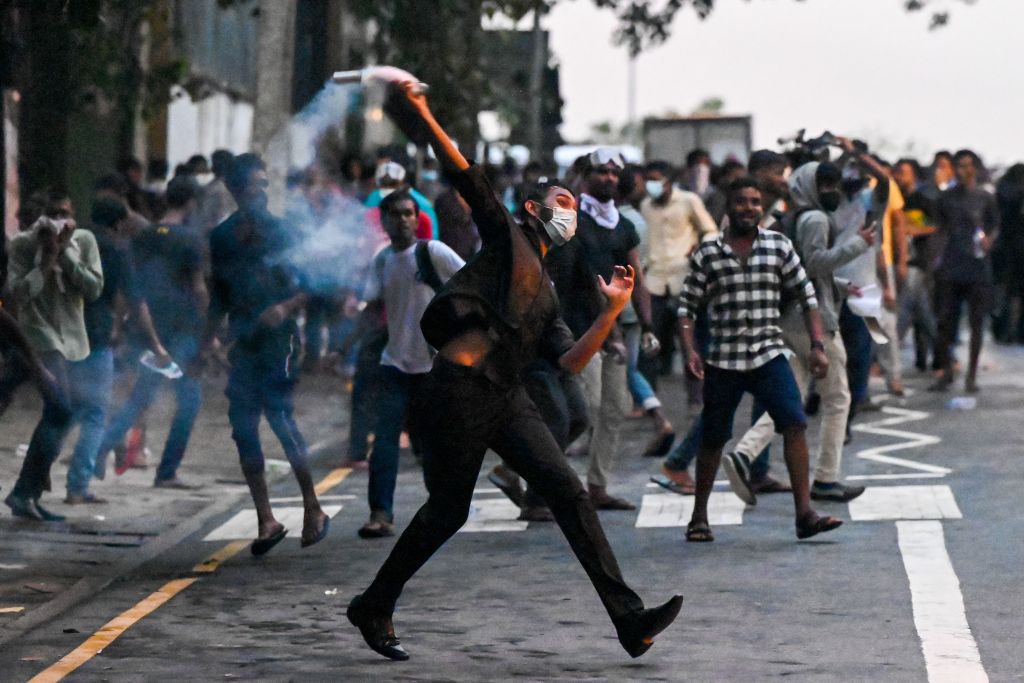
Many middle-income and developing countries are now suffering from a combination of internal political dysfunction and external economic shocks generated mainly by COVID-19 and the war in Ukraine. Sri Lanka provides a powerful example and a warning for countries in other regions that will face similar predicaments.
Sri Lanka is not a poor country. When adjusted for purchasing power, per capita GDP in this nation of 22 million people is higher than in South Africa, Peru, Egypt, or Indonesia. But the country now faces a political crisis powered by severe shortages of food, fuel, electricity, and medicine. The currency is collapsing, and the government can’t afford imports or to make its debt payments. At times in recent weeks, violent protests have threatened to spiral out of control.
How did we get here?
A quarter century of civil war, which ended in 2009, has created a legacy of violence at the heart of Sri Lanka’s politics. In 2019, a terrorist attack by an ISIS-inspired Islamist group on minority Christians made international headlines. On Easter Sunday, a series of bombs detonated in churches and hotels killed and injured hundreds of people. Those attacks, and the sense of insecurity they created across the island nation helped elect Gotabaya Rajapaksa, a former defense minister with a reputation for toughness, later that year.
Gota, as the president is widely known, then named his older brother, Mahinda, a former president, as prime minister. A landslide election victory in 2020 gave the Rajapaksas a two-thirds parliamentary majority, which then allowed them to rewrite Sri Lanka’s constitution to give the president extraordinary new powers.
Then hubris kicked in. Family and friends were given important posts in government. A series of economic mistakes, including populist tax cuts, deprived the government of revenue and made it much harder to borrow money abroad.
External shocks have also played a big role in Sri Lanka’s troubles. COVID-19 devastated a tourism sector still reeling from terrorism, a sector that’s critical for government revenue and job creation in the country. The pandemic also cut deeply into remittances, money sent home by Sri Lankans working abroad.
The increasingly unpopular Rajapaksas refused to accept the need for government spending cuts and tax increases to help Sri Lanka avoid even tougher economic conditions. A ban on chemical fertilizers to push farmers toward organic farming in the middle of the economic crisis made matters worse for the country’s food supply.
Then came Russia’s invasion of Ukraine and the damage it is now inflicting on global food and fuel prices. Russia and Ukraine are both leading exporters of grain, and the war has shut in much of that production. Russia and its ally Belarus, which also faces Western sanctions for allowing Russia to use his country’s territory as a launchpad for attacks on Ukraine, are leading producers of fertilizer. Higher prices for fuel are the natural result of supply worries that have pushed oil above $100 per barrel. Sri Lanka also imports more than 80 percent of its medical supplies. Donors in India and in Europe have helped, but there’s a limit to how much they are willing to do.
In Sri Lanka, public anger came to a head in early May. Economic pressures exacerbated infighting within the Rajapaksa family, particularly between the president and prime minister. After the government appeared to send counter-protesters to attack the mainly peaceful crowds that called for the prime minister to resign, bloodshed ensued. Enraged anti-government protesters then went on an arson spree, attacking the homes of Rajapaksa family allies, and threatening the prime minister’s own residence. The PM was forced to step down, and he needed the protection of security forces for a 4 AM evacuation of his home.
More from TIME
A state of emergency was declared across the county. Angry mobs have launched more attacks on politicians and their homes. Hundreds have been injured in recent weeks, and some have died. A member of parliament was killed in his car. Two more of President Rajapaksa’s siblings and a nephew have resigned their cabinet posts.
Late last month, Sri Lanka defaulted on its debt for the first time in the nation’s history.
What now?
President Rajapaksa, struggling to survive politically, has pledged to reverse some of the constitutional changes that gave him more power. He has accepted help for Sri Lanka’s economy from India and China, and he’s appealed to the IMF for a bailout. New Prime Minister Ranil Wickremesing, a political veteran, has been brutally honest in his public comments on the scale of the problems Sri Lanka faces and the need for bold action to solve them. He has said Sri Lanka will raise tax rates to earn a bailout from the International Monetary Fund. He then used a televised speech to call on protest groups to join in the process of reform. He pledged that parliamentary committees will allow lawmakers, young people and experts to work together.
For now, the protesters continue to demand President Rajapaksa’s resignation, though there don’t appear to be enough votes in parliament to impeach him, and the opposition looks to have little interest in sharing responsibility for cleaning up this mess by joining a government of national unity.
In short, a chastened Sri Lankan government will try to muddle through, hope the pandemic and Russia’s war in Ukraine end soon, and do its best to secure long-term financial health.
It’s a pattern that will be repeated in many developing countries in coming years.
More Must-Reads From TIME
- The 100 Most Influential People of 2024
- The Revolution of Yulia Navalnaya
- 6 Compliments That Land Every Time
- What's the Deal With the Bitcoin Halving?
- If You're Dating Right Now , You're Brave: Column
- The AI That Could Heal a Divided Internet
- Fallout Is a Brilliant Model for the Future of Video Game Adaptations
- Want Weekly Recs on What to Watch, Read, and More? Sign Up for Worth Your Time
Contact us at letters@time.com